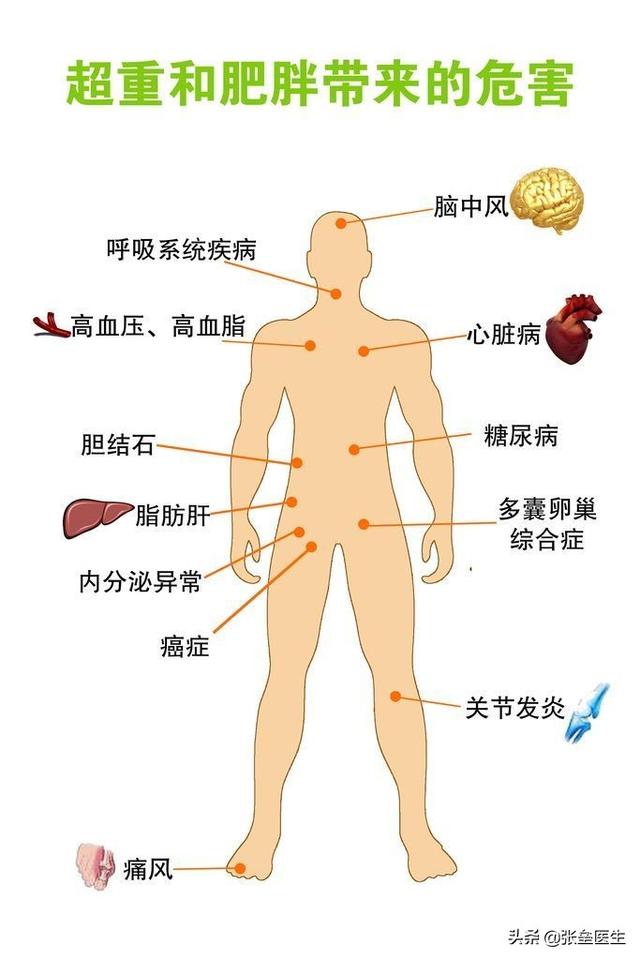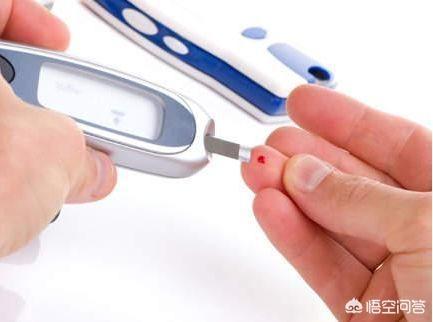Are all diabetics fat, and is there a link between obesity and diabetes?
Hello, I am Dr. Zhang base, is currently a member of the Chinese Physicians Association of Nephrology Branch, using their spare time to answer some health questions for you, feel that this knowledge is useful, please like, forward, pay attention to oh, thank you!
Are all diabetics fat? Is there a link between obesity and diabetes?
First of all, I would like to tell you that diabetic patients are not all fat people, many thin people will also get diabetes, only that the chances of fat people getting diabetes will be greater. In addition, fat people with diabetes, because of the long-term high blood glucose can not be effectively controlled, they may also become thin people!

So is there a relationship between diabetes and obesity?
The answer is yes, especially type 2 diabetes tends to obese patients are more likely to appear, type 1 diabetes patients and obesity has little to do. According to information, long-term persistent obesity patients, the probability of type 2 diabetes is more than 4 with the average person, especially to abdominal obesity patients are more likely to develop type 2 diabetes. Statistical data show that the incidence of diabetes in the normal weight population is only 0.7%, weight more than 50% of the normal value, its incidence can be as high as 10%. The incidence of diabetes is about four times higher in moderately obese people and 30 times higher in extremely obese people, and the risk of diabetes is related to the duration of obesity as well as the degree of obesity.

Why are obese patients more likely to get diabetes?
The specific mechanism is more complicated, I say a better understanding. Most obese patients will be accompanied by insulin resistance, that is, insulin insensitivity, insulin is the body's most important glucose-lowering hormone, the human body after eating, a large amount of sugar within the food will be absorbed by the intestinal tract, rely on insulin to metabolize these sugars, so that the human body's blood glucose is maintained in a standard range. Obese patients contain a large number of fat cells, these fat cells are insensitive to insulin, in order to maintain the balance of glucose metabolism in the body, obese patients tend to secrete several times more insulin than normal people in order to maintain the stability of blood glucose, in the long run, the pancreatic islets are more susceptible to damage, in addition to the obese patients tend to prefer to eat some of the high-sugar and high-calorie foods, and at the same time a lack of physical activity, a lot also Combined with high uric acid and high blood pressure, are the triggering factors of diabetes, so the chances of diabetes in obese patients will be higher.

Why do thin people get diabetes too?
As mentioned earlier, diabetes and obesity are indeed inextricably linked, and this mainly refers to type 2 diabetes. But type 1 diabetes has nothing to do with obesity. In addition, there is a family history of diabetes in the thin people are also more likely to get diabetes, so for these thin people we have to pay extra attention, can not think of themselves as all right not to pay attention to regular medical checkups and life attention amount!
It is not easy to code, we think it is useful to bother to click on the praise or forwarding support ha! If you have a health problem welcome to pay attention to, there will be asked back, I'm Dr. Zhang base, I'm in the headlines to help everyone!
Thanks for the invitation. The presence or absence of obesity in diabetes is closely related to the amount of insulin in the blood. We know that the development of diabetes is associated with a decrease in the quantity or quality of insulin. The function of insulin is familiar to everyone is that it transports glucose from the blood to the cells in order to energize the tissue cells. However, there is another function of insulin that some people may not be familiar with, and that is the conversion of excess sugar into fat to be stored in fat cells. Therefore, whenever a diabetic has hyperinsulinemia, he or she is often obese.
This makes it easier to answer this question. When a patient's tissue cells become less sensitive to insulin, the body tends to compensate by secreting more insulin. At this point, the patient tends to appear obese. When the patient's pancreatic function gradually fails, insulin secretion is absolutely reduced, and at this time, the patient is not necessarily fat.
Of course, for diabetics who have been injecting insulin for a long time, they usually also manifest obesity due to the fat-storing properties of insulin. Therefore, diabetes may not always be fat, but since the vast majority of diabetic patients show insulin resistance in the early stage, they often show obesity. Welcome to my headline-Jiangsu Provincial Cancer Hospital Li Feng.
Diabetics are not all fat. I believe that many of my diabetic friends must have seen many diabetics in outpatient clinics and wards and on various occasions, and can find that this is the case, and of course, there will be many people who will raise questions about it.
He's so skinny, how can he have high blood sugar?
It can also be turned around to say that
Are all fat people diabetic?
This is another big topic, so is there any connection between obesity and diabetes?
Of course there is, and there is a very strong correlation.
For the type 2 diabetes population, which accounts for 95% of all diabetics, obesity is an independent risk factor for the development of diabetes. This is because the pathophysiology of patients with type 2 diabetes is characterized by relative insulin deficiency and insulin resistance, and insulin resistance is more pronounced in the obese population.
Insulin resistance is common in patients with type 2 diabetes mellitus. The normal pancreatic β-cells of the body have a certain compensatory capacity for the insulin resistance state, but after prolonged overproduction, insulin resistance will further deteriorate, and persistent hyperglycemia can significantly impair the secretory response of the pancreatic islet cells to glucose stimulation, causing permanent diabetes mellitus.

With the improvement of economic level, if the nation does not improve the awareness of health, then there will be 60% of new cases of diabetes may be related to obesity and overweight. Therefore it is very important to reduce the obese population, and to reduce the incidence of obesity, it is necessary to adhere to dietary control and exercise.
Long-term persistent elevation of blood glucose, in the course of treatment, some drugs will increase the body fat synthesis, this part of the population will further increase in weight, forming a vicious circle, and further aggravate the risk of metabolic syndrome.
Abdominal obesity is associated with a higher risk of combined hypertension and cardiovascular disease, and if hyperglycemia is present, the risk of cerebrovascular disease increases 16-fold.
Diabetes is not all fat, but obesity will increase the risk of diabetes, especially type 2 diabetes, a taste of type 2 diabetes and usual diet and lifestyle habits have a very important link, but the factors of diabetes, in addition to obesity, genetics is also non-important a factor, some of these diabetics and obesity is not related. However, for diabetes, type 2 diabetes occurs more, so to prevent type 2 diabetes, or to help patients with type 2 diabetes better control of blood glucose, control a reasonable weight is very important.

In the case of diabetes, type 2 diabetes is the result of a combination of insulin resistance and failure of B-cells to secrete insulin. Increased adiposity, especially visceral fat, accelerates the process of on ahoo causing diabetes. And obesity will accelerate autoimmune-mediated destruction of B-cells, resulting in type 1 diabetes, which is why it is said that obesity is a very large factor in the prevalence of diabetes, and to control diabetes, not only to pay attention to dietary glycemic index as well as postprandial glucose, but also to pay attention to the control of the total energy intake, so as to be able to better control weight.
For diabetes, then, it is recommended to start the regimen in the following areas:
1. Control total energy intake, especially with a low-fat diet.
2. staple food coarse and fine with, even if the weight control should also eat, weight loss is more important to eat, so as to avoid the lack of energy caused by abnormal fat metabolism, and ultimately cause the ketone body elevated, triggering ketoacidosis.
3. Choose foods with a low glycemic index, but in order to prevent high blood glucose after baklava, it is recommended that a combination of meat and vegetables and vegetables at every meal can help delay postprandial blood glucose.
4. Fruits should not be eaten on an empty stomach and try to choose such as. Apples, pears, grapefruit, peaches and other fruits with a low glycemic index.
5. Stop smoking and limit alcohol.
6. Drink 1500-1700ml of water in sufficient quantity every day.
7. Exercise moderately every day, preferably for no less than one hour, but with good foot protection and comfortable clothing.
Diabetes is not all about fat people, but fat people are over or overweight mostly, accounting for more than 80% of the population, which is because obesity is the most important risk factor for diabetes.
Obesity is strongly associated with diabetes. Authoritative cross-sectional and prospective epidemiologic surveys have shown that obesity, especially centripetal obesity, is an important risk factor for diabetes.

in the first placeWhen people consume high-fat, high-energy, high-sugar foods, prompting an increase in insulin secretion, excess energy synthesized under the action of insulin fat stored in the body, so that weight gain, excessive weight gain caused by the metabolic pancreas load increases, insulin resistance.
secondlyIn normal people, there is an insulin receptor in the body, and obese people, the body lacks the insulin receptor, the sensitivity to insulin will be reduced, so obese people, it is necessary to secrete more insulin to lower the surrounding tissues, including muscle fat and liver blood glucose, in order to achieve a normal range of glucose utilization. However, too much insulin can adversely affect all other tissues of the body, including the dysfunction of the beta cells that produce it. This is called "insulin resistance syndrome".

Again.Obesity leads to hormonal disruption in the body, and hormonal disruption is also responsible for insulin resistance.
Type 2 diabetes accounts for 95% of the cases in China, and the basic pathological changes are the function of both pancreatic β-cell functional defects and insulin resistance.
Therefore, the nutritional condition associated with the development of diabetes is obesity. The primary nutritional intervention for the prevention and treatment of diabetes is the prevention of overweight or obesity (weight loss).

According to new survey data, about one in ten people in China may have diabetes. Complications caused by diabetes can also lead to death. The incidence of diabetes is gradually on the rise, and the age of patients is getting younger and younger. Many people say that there are more fat people nowadays, so there are more people suffering from diabetes. Are all diabetics fat before they get sick? What is the relationship between obesity and diabetes?
Many people say that obesity and diabetes are a pair of difficult to brother, obese people are more likely to develop diabetes than thin people, so thin people can not be afraid of diabetes, in fact, the reality is not as simple as you think. Diabetes is a chronic metabolic disease, the main reason is that the body's insulin secretion defects or its role is impaired, resulting in elevated blood sugar. For people with diabetes who are fat or thin, it actually works like this:
Type I diabetics tend to be thin in body type
Type I diabetes mellitus is caused by the destruction or damage of pancreatic β-cells, resulting in abnormal insulin secretion or loss of insulin secretion, and patients also have the typical diabetes symptoms of "three more and one less". Type I diabetes patients experience weight loss, mostly due to the lack of insulin in the body, resulting in glucose in the blood can not be absorbed by the body, so that the body metabolism of energy is not enough, the body will consume fat and protein for the normal functioning of the body, even if the patient eats a lot of food, but because of the abnormalities of digestion and absorption, energy consumption, will not be a very fat body.
Type I diabetic patients usually have a lot of complications, resulting in loss of appetite, which will reduce the amount of food intake, and over time will lead to thinness. Some type I diabetic patients are "thin as a bone" at the beginning, because type I diabetic patients need to use exogenous insulin to control blood glucose for life. When exogenous insulin enters into the body, the body restores normal glucose metabolism, and the blood glucose can be controlled smoothly, then the patient's digestive and absorptive functions can be restored to normal, and the appetite can be increased, and the figure of many patients will return to normal from thinness. The patient's digestive and absorption functions will return to normal, appetite will increase, and the patient's body shape will be restored from thinness to normal.
Type II diabetics are both fat and thin
Obese people are the high incidence of type II diabetes, obesity will lead to the body's secretion of insulin, can not effectively control the liver's output of glucose or to promote muscle, adipose tissue from the blood to draw glucose, the phenomenon of insulin resistance. For these obese diabetic patients, the first task is to lose weight, only weight will be to the normal range, in order to improve the insulin resistance, increase the liver's utilization of glucose in the blood, so that blood glucose is reduced, thereby improving the effectiveness of diabetes treatment.
But there are some type II diabetes patients are not fat, this is because the causative factors of type II diabetes, in addition to obesity, there are environmental factors and genetic factors, if a person often work overtime and stay up late, resulting in metabolic disorders in the body, coupled with irregular diet, even if the body type is not fat will suffer from diabetes; in addition to the family's genetic factors, but also greatly increase the prevalence of diabetes, if there are a few family members with diabetes, no matter whether you are obese or not, must pay attention to blood glucose monitoring, because your prevalence is higher than that of other people. If your family has several diabetic relatives, no matter whether you are obese or not, you must pay attention to blood glucose monitoring, because your prevalence rate is higher than that of others.
Regardless of fat or thin, look at the body shape is not to determine whether the standard of diabetes, only to go to the regular hospital to monitor blood glucose, is to determine whether the "gold" standard of diabetes.

If you have a good suggestion for this issue, you are welcome to leave a comment below!
I am Wang Guizhen, today's headline Wukong Q&A signed author, welcome to pay attention to [Wang Guizhen nutritionist] headline number, together to talk about health, so that we eat healthy, eat at ease!
Hello friend, there is a reason for what happened and a reason for the question. I think it should be you or your family suffer from obesity and blood sugar kinda like, then let me give you the answer to the following, obesity and diabetes in the end how much relationship, and how to improve.

First of all, we can tell you for sure that obesity and diabetes have an inseparable relationship, even closer than husband and wife! If you do not believe that there is data as evidence, in the long-term obese people, the prevalence of diabetes is more than 4 to 5 times the average person. In addition, 80% of type 2 diabetics are obese.
So, obesity and diabetes are a difficult pair. So how should we improve or what should we pay attention to?

The first thing you should do in your diet is to watch your sugar intake and control the intake of pure sugar and pure energy foods. For example, fried and pan-fried foods, desserts, fine grains, candies, fruits. Everything related to sugar should be eaten less. There is also porridge food to pay attention to, especially white porridge. Because the process of cooking congee is the process of carbohydrate dextrinization, there is a substance called dextrin inside the congee, which raises the blood sugar speed is very fast.
There is also attention to exercise, do not need to be how strenuous, the face is to often go outdoors to walk, run. The beginning said, obesity and diabetes have a close relationship, exercise is to lose weight to avoid getting diabetes, the reverse is also true, diabetic patients should also rely on exercise to maintain a healthy weight, so that the condition does not worsen.

Obesity and diabetes have a common pathogenesis, and obesity is a stage in the development of type 2 diabetes. Both are chronic metabolic syndromes caused by disorders of the intestinal flora. However, not all type 2 diabetics are obese, but it must be intestinal flora structure disorder.
The structure of intestinal flora is disturbed, the proportion of beneficial bacteria using dietary fiber as substrate decreases, harmful bacteria using proteins and mucus substances as substrate proliferate and produce a large amount of endotoxins (also some proteins), at the same time, the number of beneficial bacteria using dietary fiber as substrate that are supposed to secrete short-chain fatty acids, especially butyrate, which are important nutrients for intestinal mucosal epithelial cells, is too small, so that the The intestinal mucosa cannot be kept in a healthy state, and both the barrier and transduction functions are destroyed, and endotoxins produced by harmful bacteria (beneficial bacteria also produce endotoxins, in different amounts), as well as other harmful substances, enter the bloodstream through the destroyed intestinal barrier, and some of the viable bacteria enter the bloodstream as well, causing systemic inflammation, and triggering insulin resistance, which leads to impaired glucose-lipid metabolism.
About this mechanism, scientists did this experiment, the endotoxin extracted, injected into the body of healthy mice, in the low-fat and low-sugar healthy dietary conditions, the mice still got fat, indicating that the endotoxin into the blood can directly lead to obesity, of course, more and more in-depth research also shows that, in addition to endotoxin, there are other harmful substances into the blood, but also can cause obesity. And about the bacterial translocation and type 2 diabetes related, is in a large number of volunteers to do genetic sequencing of blood bacteria, found that share certain blood bacteria gene content is higher, years later, are suffering from type 2 diabetes.
Therefore, whether it is obesity or type 2 diabetes mellitus, there is a direct correlation with the intestinal flora, are because of intestinal flora dysfunction, intestinal barrier is destroyed induced by the chronic metabolic syndrome, this mechanism is now in the scientific community has basically reached a consensus, while in the medical and pharmaceutical research, it takes a longer time.
Based on the above pathogenesis, for obesity and type 2 diabetes mellitus, targeting the intestinal flora to repair the intestinal barrier, reduce systemic inflammation, and eliminate insulin resistance is the direction of new drug development in the future; however, at the same time, because of the large number and very diverse nature of intestinal flora, it is a must for any drug to be coupled with scientific dietary management.
In summary, obesity and type 2 diabetes are chronic metabolic syndromes caused by intestinal flora disorders, and many obese people will later develop type 2 diabetes and other chronic metabolic syndromes related to intestinal flora disorders, such as non-alcoholic fatty liver disease and colorectal cancer.
When a person whether through exercise, dieting can not make weight reduction, it should be alert, in fact, this is already a stage of chronic metabolic syndrome, meaning that eating less is not necessarily thin, because the intake of energy is one aspect, the body metabolism is a more important aspect of eating very little, but not according to the normal path of metabolism, so the weight is always out of control, because of short-chain fatty acids through the nerve conduction of the role of inhibition of appetite, so at this time also can not control a lot of food intake. Because short-chain fatty acids have the effect of suppressing appetite through nerve conduction, so at this time also can not control a large amount of food intake.
And from a large number of intervention examples can be seen, belonging to the intestinal flora disorders caused by obese people, in the scientific intervention about a month or so, intestinal discomfort of all kinds of problems will be solved, in the absence of strict control of dietary conditions, the weight will still be reduced by 10-20 pounds, and thereafter normal diet and will not weight gain.
For people of normal weight, avoiding a high-fat, high-sugar diet and consuming an adequate amount of dietary fiber is important for weight maintenance and prevention of type 2 diabetes and other related chronic metabolic syndromes.
To learn more about dietary interventions for type 2 diabetes and obesity, follow Infertility Bio by pressing + on the right!
Theoretically, both fat and thin people can suffer from diabetes, but why is it that fat people are perceived as diabetes specialists?
Diabetes favors fat people, and obese people are more likely to develop diabetes; the two usually go hand in hand and are both components of the metabolic syndrome.
This is because.Obesity and the occurrence of diabetes have a common "soil", is insulin resistance, the beginning of insulin resistance, the body will be compensatory secretion of more insulin to maintain stable blood glucose, the body is in a state of hyperinsulinemia, compensatory function is not enough to maintain stable blood glucose, blood glucose gradually rise, pancreatic islet function gradually fail, and after that, blood glucose is getting higher and higher. Blood glucose is getting higher and higher, and the pancreatic islet function is getting exhausted. Therefore, keeping the body weight within a reasonable range is a measure to prevent diabetes.
[Professional doctor to answer your questions

The answer is: diabetes is not fat people will get, but the occurrence of diabetes and obesity have a direct relationship, and obesity has become one of the most important reasons for the occurrence of diabetes, why?
It is well known that the immediate manifestation of diabetes is an increase in blood sugar, and there are two main reasons for this outcome:
First, insufficient insulin secretion, insulin is secreted by pancreatic islet cells, pancreatic islet cells are very sensitive to the elevation of blood glucose, it can be said to regulate the amount of secretion of the "switch", with the digestion and absorption of food after meals, blood glucose is bound to rise, and immediately stimulate the pancreatic islet cells to secrete a large amount of insulin because the role of insulin is to transport the glucose into the body's cells for utilization of the transporter, and if the islet cells are damaged or partially dead, the ability to respond to the stimulation of high blood glucose decreased, the blood glucose will rise without utilization. Because the role of insulin is to transport blood glucose into the cells of the whole body for the use of transporters, if the pancreatic islet cells are damaged or partially dead, the ability to respond to the stimulation of high blood glucose decreases, the secretion of insulin is not enough, blood glucose can not be utilized to rise. In addition, insulin also assumes the role of converting excess blood sugar into fat for storage in internal organs and subcutaneously. If there is insufficient insulin, this conversion will be weakened and fat synthesis will be reduced.

The second is insulin resistance, that is, when insulin transports blood glucose into the tissue cells, the channels (receptors) on the cells that accept insulin to enter are blocked, and blood glucose is unable to enter the cells and remains in the blood in large quantities, leading to further elevation of blood glucose. Elevated blood sugar and constantly stimulate the pancreatic islet cells to secrete more insulin, on the one hand, increased the burden on the pancreatic islet cells, and will be damaged, on the other hand, too much insulin into the cells, so the blood sugar in the blood is converted into fat storage, due to the storage site is mainly visceral organs and subcutaneous, so obesity occurs and is the belly type of large centripetal obesity.
Research has confirmed that: in the early stage of diabetes, the main cause of elevated blood glucose is insulin resistance, thus in the blood glucose has risen when it will lead to obesity; and insulin resistance occurs due to obesity caused by the image that is too much fat accumulated in the cell membrane blocked insulin into the channel, the two cause and effect of each other, so that the phenomenon of insulin resistance is gradually aggravated. But this situation greatly aggravates the burden of pancreatic islet cells, over time the islet cells will be damaged or even death, insulin secretion is reduced, the cause of high blood glucose from insulin resistance to insulin secretion is insufficient, the weight will continue to fall or even lose weight.

In summary, obesity can lead to the occurrence of diabetes mellitus, in the early stage of diabetes mellitus can lead to obesity, with the prolongation of the duration of the disease or poor glycemic control, the weight will continue to decline; the same reason, when the thin diabetic patients with effective glycemic control, the body weight will gradually increase, so the weight change of diabetic patients can indirectly reflect the glycemic control of the good or bad, and to maintain an ideal body weight is the goal to be paid attention to and strive to achieve in the treatment of diabetes mellitus. Maintaining an ideal weight is also a goal that needs to be paid attention to and realized in diabetes treatment.
I hope this answer can help you, welcome to click on the attention and leave a message, together to learn and exchange more health knowledge.
This question and answer are from the site users, does not represent the position of the site, such as infringement, please contact the administrator to delete.